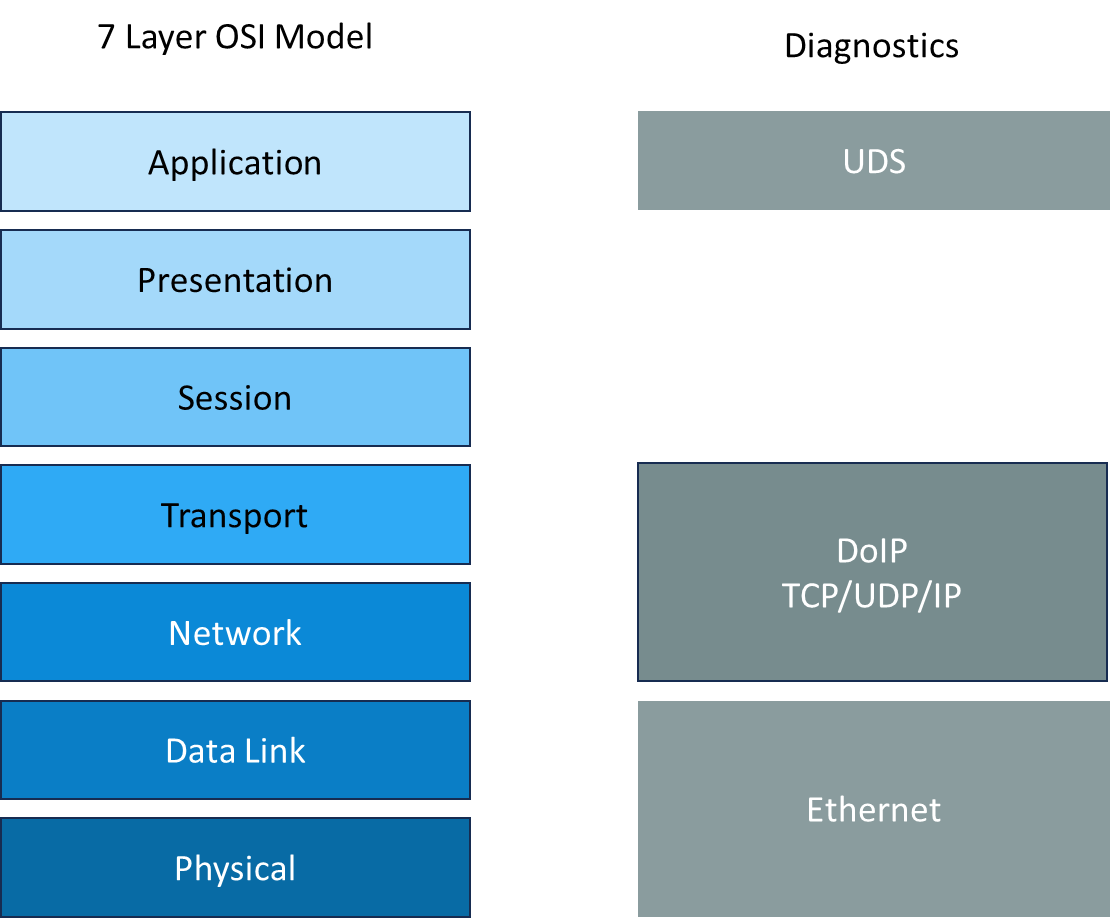ISO13400 - DoIP Protocol
DoIP Overview
Diagnostics over Internet Protocol (DoIP) is a diagnostic communication protocol used in electronic control units (ECUs) within automotive electronics, which is specified in the ISO13400
Embien’s DoIP stack covers all the services defined as part of the ISO13400 standard specification, enabling diagnostic communication between ECUs and tester/programmer devices. Our UDS stack is implemented on top of the DoIP network layer - defined as ISO13400 specification.
Some of the salient features of RAPIDSEA DoIP protocol stack are
Support for both server mode and client mode
Configurable block size and network timings
ISO-TP layer with up to 4095 bytes transfer support
MISRA-C compliant ANSI C source code
Can be used with or without RTOS
Supports rates of upto 100 mbps
Can support 8, 16, 32, 64-bit CPUs
Can transfer data in single frame.
Ports are available for all major embedded platforms including Renesas, NXP, TI, Microchip MCUs etc.
The OSI layer model of DoIP

DoIP Packets Structure Info


Refer to the ISO14229 - UDS Protocol page for an example about how the RAPIDSEA UDS stack uses the DoIP.
The implementation is fully configurable and are offered for both server and client mode of operation.
Supported Ports
Following ports are supported in DoIP Stack
Name |
Port Number |
Description |
|---|---|---|
UDP_DISCOVERY |
13400 |
The UDP port on which the server listens to for incoming requests and commands. Also optionally utilized as source port for broadcast packets |
UDP_TEST_EQUIPMENT_REQUEST |
Dynamically assigned |
UDP Port from which the client transmits messages. Also can be used as destination port for response |
TCP_DATA |
|
TCP Port at which the server listens for incoming connection requests. |
Supported Payloads
Following Payloads are supported in the DoIP Stack
Payload Type Value |
Payload Type Name |
From |
To |
Description |
|---|---|---|---|---|
0x0000 |
Generic DoIP header negative acknowledge |
Server |
Client |
DoIP header NACK send by server if received DoIP packet does not match with some conditions. |
0x0001 |
Vehicle identification request message |
Client |
Server |
Vehicle identity request send by client to get vehicle details like VIN,GID,EID,Logical address. |
0x0002 |
Vehicle identification request message with EID |
Client |
Server |
Send vehicle identity request with already known EID. |
0x0003 |
Vehicle identification request message with VIN |
Client |
Server |
Send vehicle identity request with already known VIN. |
0x0004 |
Vehicle announcement message/vehicle identification response message |
Server |
Client |
Send vehicle identity response with details like VIN,GID,EID,Logical address. |
0x0005 |
Routing Activation Request |
Client |
Server |
Routing activation request send by client with client source address to configure with server. |
0x0006 |
Routing activation response |
Server |
Client |
Server sent the routing activation response after the client source address was stored. |
0x0007 |
Alive check request |
Server |
Client |
Request sent by the server to check whether the client is connected or not. |
0x0008 |
Alive check response |
Client |
Server |
Response sent by the client if it is connected with server. |
0x4003 |
Diagnostic power mode information request |
Client |
Server |
Request sent by client whether the server is ready for diagnostic process. |
0x4004 |
Diagnostic power mode information response |
Server |
Client |
Server sends its status whether it is ready or not as response. |
0x8001 |
Diagnostic message |
Both server and client |
Both server and client |
Send and receive UDS messages via diagnostic message payload type. |
0x8002 |
Diagnostic message positive acknowledgement |
Server |
Client |
If the diagnostic request message satisfies certain conditions, then the server will send a diagnostic positive response. |
0x8003 |
Diagnostic message negative acknowledgement |
Server |
Client |
If the diagnostic request message not satisfies certain conditions, then the server will send a diagnostic negative response. |
This can be implemented in a bare-metal system or over RTOS or over full fledged OS such as Linux etc.
DoIP Server
DoIP Server is typically implemented in the ECUs so that the client (Tester) can connect to it and perform various diagnostics operations on the same. RAPIDSEA implements the DoIP server with the following features.
Support for all the Payloads
Modular and extensible design
Portable across architectures
The DoIP Server stack implementation is covered in detail in the DoIP (ISO13400) Server Stack page.
DoIP Client
RAPIDSEA implements UDS client where different types of services can be performed on the ECUs. APIs are provided to perform services on the server with high level of control and performance
The DoIP Client stack implementation is covered in detail in the DoIP (ISO13400) Client Stack page.
DoIP Header Details
Documentation from the relevant header as follows:
Warning
doxygenfile: Cannot find file “rs_iso13400.h